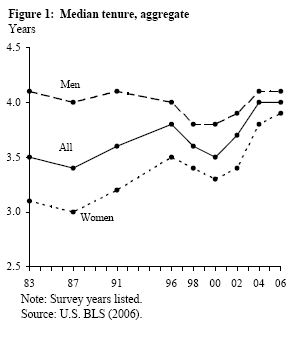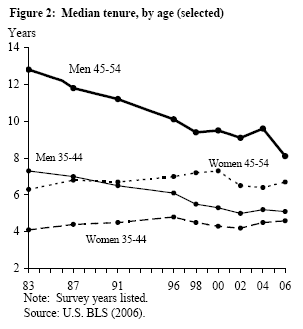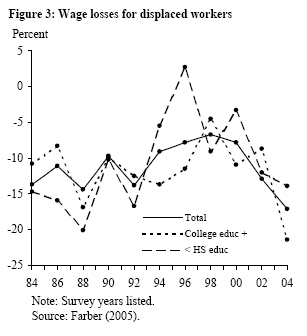In recent years, the U.S. economy has expanded at a healthy pace, employment has grown substantially, and the unemployment rate has dropped to very low levels. Despite these favorable trends, some recent news stories have emphasized worker anxiety and uncertainty about their job stability and security, reinvigorating a theme that gained substantial prominence in the mid-1990s.
- Declining job stability
- Job loss and job security
- Increasingly severe consequences
- Discussion
- References
In recent years, the U.S. economy has expanded at a healthy pace, employment has grown substantially, and the unemployment rate has dropped to very low levels. Despite these favorable trends, some recent news stories have emphasized worker anxiety and uncertainty about their job stability and security, reinvigorating a theme that gained substantial prominence in the mid-1990s. Research economists who have investigated this topic in general have not subscribed to the view that rising worker anxiety reflects widespread, long-term changes in labor market conditions; rather, some have argued that claims of declining job stability are exaggerated (e.g., Stevens 2005), perhaps due to changes in employment conditions for small, high-profile groups, such as skilled white-collar workers.
In this Economic Letter, I explore trends in job stability and job loss and their consequences over the past two to three decades. The findings reported shed light on why some worker groups might have reason to feel anxious.
 The most obvious and most commonly used measure of job stability and security is job tenure, essentially the length of time that a particular job lasts. Since 1983, the U.S. Bureau of Labor Statistics (BLS) has periodically published tabulations of years of tenure for wage and salary workers overall and by age and sex. Figure 1 displays selected results from the two most recent BLS tenure releases (U.S. BLS 2006; data back to 1983 are in the 2004 release), specifically, the median (midpoint) of the distribution of years of tenure reported for all respondents in the group. Tenure is measured at the time of the survey (January or February for each labeled year) and as such represents an “interrupted” measure of job duration that is shorter than the length of a typical completed job. Nevertheless, trends in this measure are likely to mirror trends based on estimates of completed job duration. Figure 1 shows that overall tenure increases a bit between 1983 and 2006, suggesting that job stability rose during this period. By sex, tenure was unchanged for men and rose noticeably for women.
The most obvious and most commonly used measure of job stability and security is job tenure, essentially the length of time that a particular job lasts. Since 1983, the U.S. Bureau of Labor Statistics (BLS) has periodically published tabulations of years of tenure for wage and salary workers overall and by age and sex. Figure 1 displays selected results from the two most recent BLS tenure releases (U.S. BLS 2006; data back to 1983 are in the 2004 release), specifically, the median (midpoint) of the distribution of years of tenure reported for all respondents in the group. Tenure is measured at the time of the survey (January or February for each labeled year) and as such represents an “interrupted” measure of job duration that is shorter than the length of a typical completed job. Nevertheless, trends in this measure are likely to mirror trends based on estimates of completed job duration. Figure 1 shows that overall tenure increases a bit between 1983 and 2006, suggesting that job stability rose during this period. By sex, tenure was unchanged for men and rose noticeably for women.
Examining median tenure for the entire male and female workforces is a fundamentally flawed basis for making inferences regarding changing job stability, however, because it ignores the significant aging of the U.S. workforce that occurred over this period. As the BLS notes, population aging tends to increase measured tenure for the workforce as a whole, because young workers have not worked long enough to acquire much tenure, and typical career paths entail job shopping early on and more durable job matches later. For example, in 1983, median tenure for men aged 25-34 was 3.2 years, while it was 15.3 years for men aged 55 to 64.
 A more careful examination of job stability is enabled by the BLS breakdown of median tenure for 16 groupings by sex and detailed age groups. Within these groups, median job tenure was flat or down since 1983 in all but two cases: women aged 35-44 and women aged 45-54, for whom median tenure rose about six months; by contrast, job tenure fell substantially for men in those same age groups (Figure 2). Job tenure also fell substantially for men aged 55-64, and it fell slightly for men aged 25-34. In percentage terms, median tenure fell about 30% for men aged 35-44 and 37 to 38% for men aged 45-64 (e.g., median tenure fell from 12.8 to 8.1 years for men aged 45-54, which is a 37% decline from the 1983 value). These declines in stability apply to a substantial share of the labor force: for example, men aged 35-64 accounted for nearly one-third of all employed individuals in 2006.
A more careful examination of job stability is enabled by the BLS breakdown of median tenure for 16 groupings by sex and detailed age groups. Within these groups, median job tenure was flat or down since 1983 in all but two cases: women aged 35-44 and women aged 45-54, for whom median tenure rose about six months; by contrast, job tenure fell substantially for men in those same age groups (Figure 2). Job tenure also fell substantially for men aged 55-64, and it fell slightly for men aged 25-34. In percentage terms, median tenure fell about 30% for men aged 35-44 and 37 to 38% for men aged 45-64 (e.g., median tenure fell from 12.8 to 8.1 years for men aged 45-54, which is a 37% decline from the 1983 value). These declines in stability apply to a substantial share of the labor force: for example, men aged 35-64 accounted for nearly one-third of all employed individuals in 2006.
These figures on job tenure by age indicate that declining job stability is obscured by the changing composition of the workforce. The substantial decline in male job stability implied by the age group-specific figures cited here is largely confirmed by Farber (2007) using more elaborate statistical methods. His findings partly conflict with Stevens (2005), who found only a slight decline in the duration of longest jobs held by older male workers in various surveys conducted between 1980 and 2002 (preceded by an increase between 1969 and 1980). However, because Stevens’s sample is limited to individuals aged 58-62 at the time of each survey, she excludes individuals born after 1944. As such, she ignores changes in job stability experienced by these more recent birth cohorts (including individuals up to age 61 in 2006).
The conflict between the sharp decline in male job stability and the slight increase in female job stability among workers aged 35-54 raises the important distinction between voluntary and involuntary job transitions. This distinction is obscured by data on job tenure, since changes in tenure can arise due to changes in either type of transition. In particular, rising tenure for women aged 35-54 is unsurprising, given the rising labor force attachment of women of prime child-rearing ages over this period, and it likely reflects voluntary behavior on their part (i.e., less frequent labor market withdrawal during child-rearing years). By contrast, declining job tenure for men of a similar age is unlikely to reflect a desire for shorter jobs but instead may reflect increasing incidence of involuntary job loss.
Data on involuntary job loss are available from the BLS Displaced Worker Survey (DWS), conducted every other year since 1984. This survey provides information on workers who involuntarily and permanently lost a job during the three years preceding the survey for such reasons as plant closures, slack work, or elimination of a position or shift. Farber (2005) analyzed results from every DWS survey through 2004 using consistent methods and found that, measured as a share of employment, the displacement rate in the 2004 survey (years 2001-2003) was almost as high as it was in the 1984 survey, despite a much lower unemployment rate in the later period. This indicates that permanent job loss has become a more important feature of the economy over the past few decades, relative to general labor market conditions as reflected in the unemployment rate. Moreover, Farber found that the upsurge in displacement during 2001-2003 was especially notable for the most highly educated workers, for whom rising anxiety has been a subject of recent news stories.
The DWS is a somewhat restricted sample, focusing on a subset of unemployed workers who lost jobs for particular reasons. Broader analysis also has been done, however. Using data from the monthly CPS surveys, which provide information on a representative sample of all unemployed individuals, Valletta (2005) uncovered a trend towards a rising share of involuntary job losers among the newly unemployed during the years 1976-2004. The implied increase in the importance of permanent job loss could be expected to contribute to workers’ sense of insecurity over this period.
Important additional information regarding job security can be obtained through analysis of the pattern of job loss across worker groups. Valletta (1999) found that rising involuntary job loss was most pronounced for workers with substantial job seniority (based on data from the mid-1970s through the early 1990s). Job security is an important and valued job characteristic for these workers, as reflected in their relatively durable job attachments up to the point of involuntary separation. Increases in job loss for such workers likely contributed importantly to declining job stability and security over the sample frame in Figures 1 and 2 (at least through the early 1990s).
Increasingly severe consequences
The consequences of job loss also may contribute to worker anxiety. The primary consequence is lost earnings, an important component of which is the direct losses incurred during the period of time spent unemployed. Valletta (2005) found that unemployment durations have been rising over the past few decades, particularly for involuntary job losers, indicating that the direct earnings losses associated with job loss probably are rising as well.
 Reduced earnings in jobs obtained following involuntary unemployment spells arguably are even more important than the direct earnings losses incurred during unemployment, since the indirect impact of job loss on earnings may be long lasting. Farber (2005) provided a detailed analysis of earnings losses in post-displacement jobs, using the DWS and a sophisticated statistical technique designed to isolate earnings losses due to displacement per se, uncontaminated by systematic differences in the characteristics of displaced and non-displaced workers. Figure 3 displays a selected subset of his findings. The decline in earnings due to displacement was about 17% on average for workers displaced during 2001-2003 (2004 survey), which represents an increase from losses of about 9 to 14% during comparable periods around past recessions (1981-1983 and 1991-1993). The figure also shows that the recent surge in post-displacement earnings losses was most pronounced for highly educated individuals, whose typical earnings loss was about 21% during the 2001-2003 period.
Reduced earnings in jobs obtained following involuntary unemployment spells arguably are even more important than the direct earnings losses incurred during unemployment, since the indirect impact of job loss on earnings may be long lasting. Farber (2005) provided a detailed analysis of earnings losses in post-displacement jobs, using the DWS and a sophisticated statistical technique designed to isolate earnings losses due to displacement per se, uncontaminated by systematic differences in the characteristics of displaced and non-displaced workers. Figure 3 displays a selected subset of his findings. The decline in earnings due to displacement was about 17% on average for workers displaced during 2001-2003 (2004 survey), which represents an increase from losses of about 9 to 14% during comparable periods around past recessions (1981-1983 and 1991-1993). The figure also shows that the recent surge in post-displacement earnings losses was most pronounced for highly educated individuals, whose typical earnings loss was about 21% during the 2001-2003 period.
The consequences of job loss go beyond reduced earnings. In the United States, workers who lose jobs often lose health insurance coverage for extended periods, and workers with unstable job histories often find it difficult to accumulate adequate funds for retirement. Such losses reinforce the earnings losses associated with job instability and could be expected to deepen worker anxiety.
The substantial declines in job stability for prime-age men documented here, in conjunction with the high rates of permanent job loss (relative to the unemployment rate) and large associated earnings losses found in other research, lend credence to the view that worker anxiety about job stability and security is real rather than illusory. At the same time, the burden of job loss and its consequences, most notably earnings losses, has shifted towards groups like the highly educated that may be especially visible in media coverage of labor market trends. Overall, the findings discussed here suggest that observable changes in labor market outcomes in the U.S. may have contributed to anxiety, at least for some groups of workers.
Rob Valletta
Research Advisor
[URLs accessed May 2007.]
Farber, Henry S. 2005. “What Do We Know about Job Loss in the United States? Evidence from the Displaced Workers Survey, 1984-2004.” FRB Chicago Economic Perspectives 29(2), pp. 13-28.
Farber, Henry S. 2007. “Is the Company Man an Anachronism? Trends in Long-Term Employment in the U.S., 1973-2006.” Working Paper, Princeton University (February 27).
Stevens, Ann Huff. 2005. “The More Things Change, the More They Stay the Same: Trends in Long-Term Employment in the United States, 1969-2002.” NBER Working Paper 11878 (December).
U.S. Bureau of Labor Statistics. 2006. “Employee Tenure in 2006.” USDL News Release 06-1563 (September 8). (2004 release).
Valletta, Robert G. 1999. “Declining Job Security.” Journal of Labor Economics 17(4, part 2), pp. S170-S197.
Valletta, Robert G. 2005. “Rising Unemployment Duration in the United States: Causes and Consequences.” Manuscript, FRBSF.
Opinions expressed in FRBSF Economic Letter do not necessarily reflect the views of the management of the Federal Reserve Bank of San Francisco or of the Board of Governors of the Federal Reserve System. This publication is edited by Anita Todd and Karen Barnes. Permission to reprint portions of articles or whole articles must be obtained in writing. Please send editorial comments and requests for reprint permission to research.library@sf.frb.org